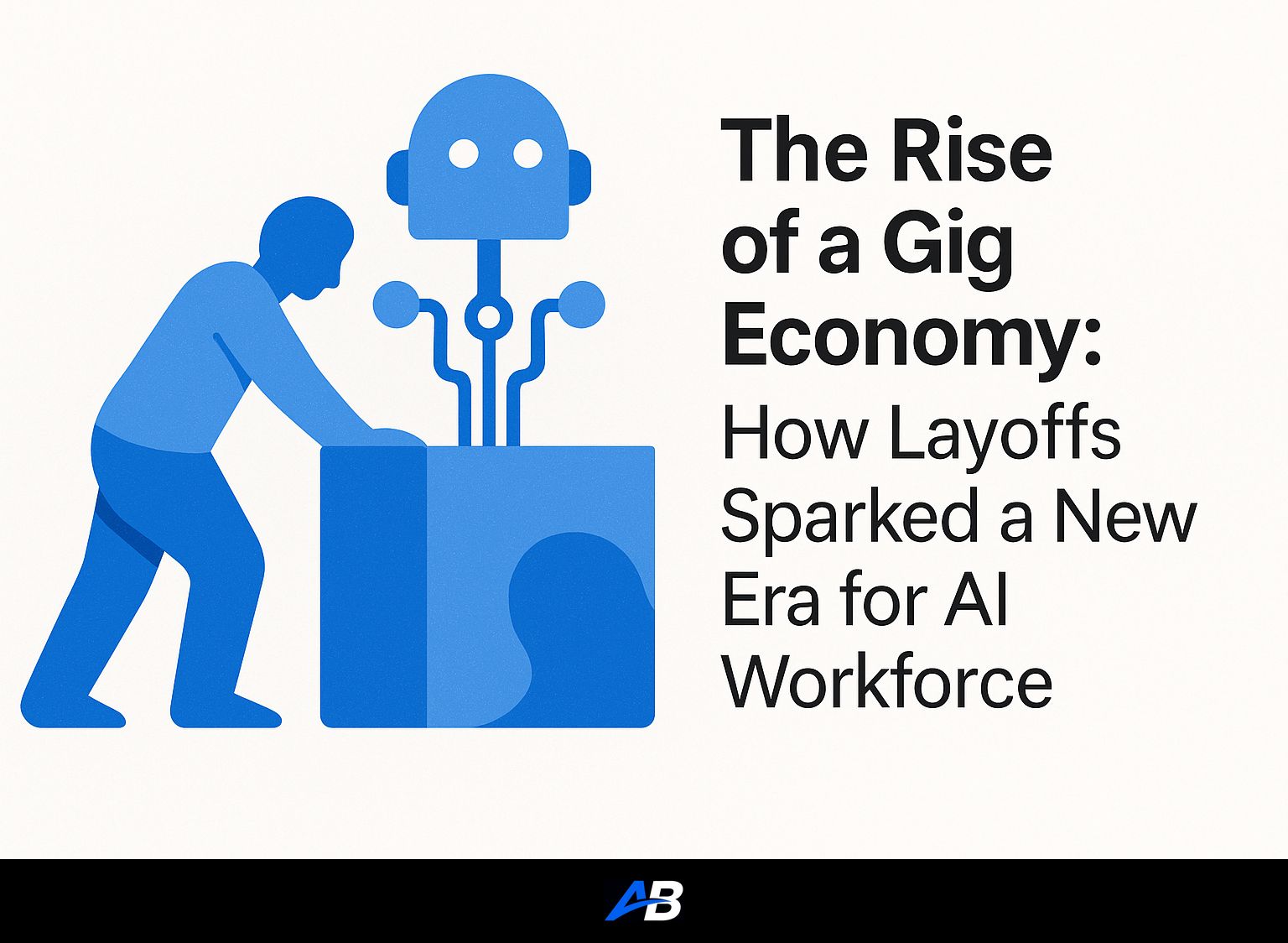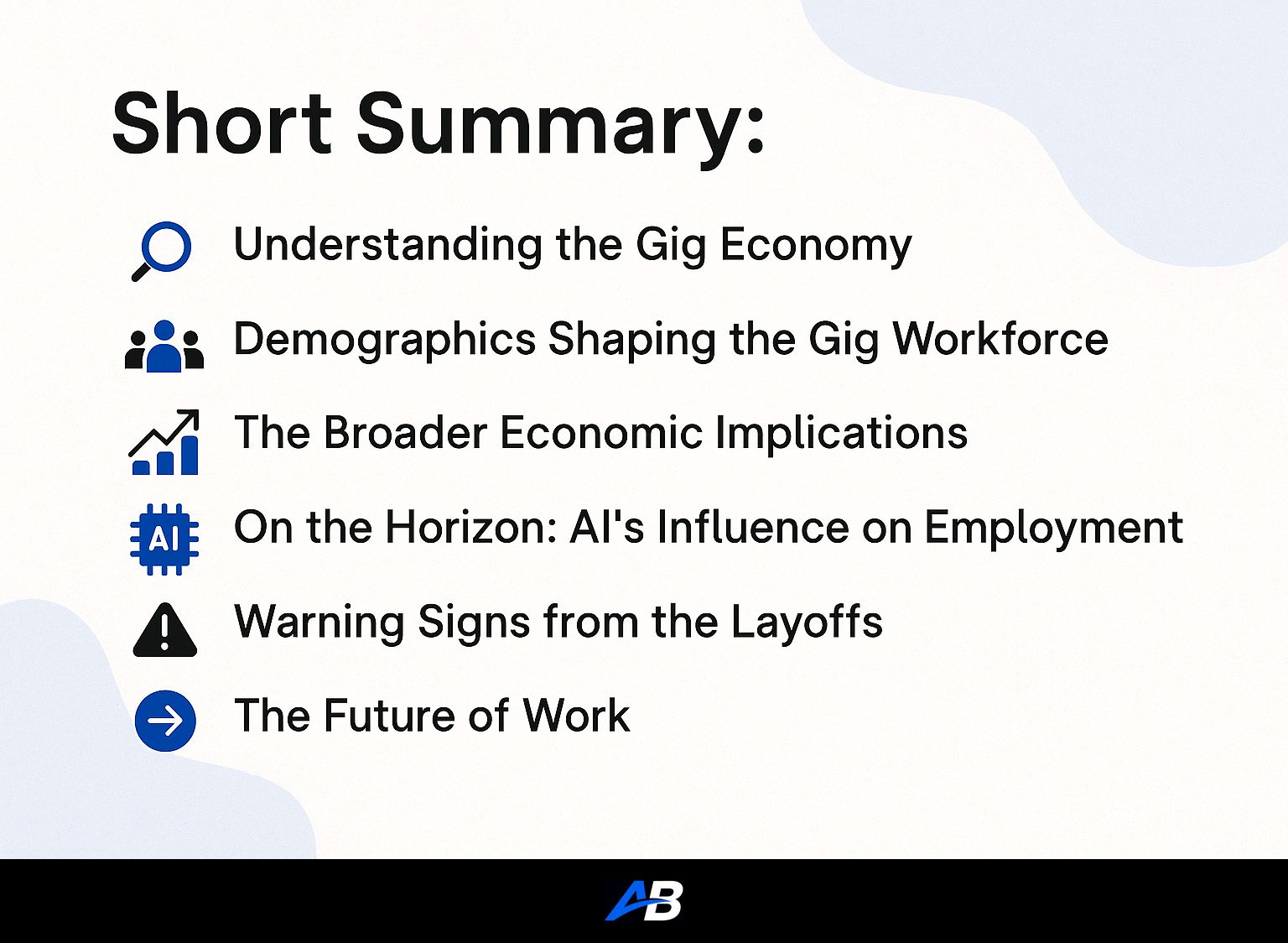The gig economy is rapidly evolving, significantly influenced by layoffs in traditional employment models and the swift advancement of AI technologies that are reshaping the workforce landscape.
Contents
Short Summary:
- The gig economy is expanding as individuals seek flexibility and new income sources amidst job cuts.
- Artificial intelligence plays a crucial role in reshaping work, automating processes, and matching freelancers with opportunities.
- Demographic shifts show that young professionals, parents, and retirees are increasingly turning to gig work for varied reasons.
The American workforce is undergoing a seismic shift, one that’s less about conventional jobs and more about tapping into the uncharted waters of the gig economy. With sweeping layoffs affecting both white-collar and blue-collar workers across sectors, there’s a remarkable exodus towards gig-based roles. Individuals are embracing platforms like Uber, Upwork, and Fiverr, gravitating towards jobs that offer flexibility, autonomy, and a way to navigate the turbulent economic landscape.
As we watch this transformation unfold, the role of artificial intelligence (AI) becomes crucial. AI technologies are not merely enhancements; they are catalysts for profound changes in how gig work is structured and managed. For instance, consider how AI-driven agents are reshaping the nature of tasks and employment opportunities:
AI can match freelancer skills with project requirements, effectively streamlining job placement and improving job satisfaction for both freelancers and clients.
The automation of administrative tasks such as invoicing, payments, and contract management has allowed gig workers to concentrate on their craft, thereby boosting their productivity and potential earnings. Furthermore, AI’s capability to provide real-time feedback is a game-changer, enabling workers to hone their skills and consistently deliver higher-quality results.
Understanding the Gig Economy
But why would individuals opt for gig work in the first place? Let’s peel back the layers of motivation behind this shift:
- Flexibility: Gig work often allows individuals to choose their hours and workload, a flexibility that traditional 9-to-5 jobs rarely afford.
- Work-Life Balance: With gigs, many can tailor their work commitments to fit personal responsibilities, like caregiving or education.
- Control Over Projects: The gig economy empowers individuals to select tasks that align with their interests, enabling greater job satisfaction.
- Supplemental Income: For many, this form of work serves as a financial lifeline to cover everyday expenses or save for life goals.
- Entrepreneurial Aspirations: Freelancing often serves as a testing ground for aspiring entrepreneurs, providing key insights and experience.
- Economic Resilience: In an age of layoffs, diversified income streams offer a sense of security that traditional employment can’t guarantee.
As the gig economy grows—boosted by AI capabilities—there’s a notable rise in the number of digital nomads. These modern workers thrive on the flexibility that allows them to work anywhere in the world, fueled by technology that seamlessly connects them with clients globally. AI-powered collaboration tools have simplified not only communication but also payments and project management, fostering an environment where mobility and work can intersect more fluidly.
Demographics Shaping the Gig Workforce
Millennials and Generation Z dominate the gig economy. These generations naturally lean towards technology and seek jobs that fit their evolving lifestyles.
However, this isn’t limited to youth: parents often turn to gig work to balance childcare duties with their careers; students frequently embrace gig jobs for extra income; and even retirees utilize the gig economy as a way to remain active or supplement their pensions. Those with disabilities often find gig work a more accessible solution than traditional employment.
The Broader Economic Implications
As we delve into the ramifications of this shift, we find a complex interplay between opportunity and risk. While the gig economy fuels economic activity, it also raises questions about job security and wage stagnation. An influx of gig workers can lead to potential exploitation and a race to the bottom in terms of pricing. Many workers are no longer employed directly by clients but rather through AI-managed platforms that dictate terms and conditions.
Therefore, it is essential for policymakers to engage with this new economic landscape, crafting legislation that protects gig workers while ensuring the evolving role of AI enhances opportunity rather than diminishes it. Solid guidelines must focus on:
- Worker classification and benefits
- Transparent AI decision-making processes
- Data privacy protections and preventive measures against discrimination
This proactive approach will be vital in enhancing the intersection of AI technology and gig work. After all, understanding the shifts in this landscape is crucial for workers and businesses alike, who must adapt to new demands and engage with gig platforms wisely to ensure competitive advantages in a rapidly changing market.
On the Horizon: AI’s Influence on Employment
The onset of AI’s impact on employment has triggered a wave of massive layoffs in companies across the United States. Corporate giants like Amazon have announced significant job cuts, with many citing AI as a reason behind the downsizing.
“AI is enabling companies to innovate much faster than ever before,” stated Amazon’s HR executive. “We now need to be organized more leanly, requiring fewer layers to drive our growth.”
Despite the rationale, experts caution that there’s more to these layoffs than merely technological advancement. While it’s true that many companies are lighting the torch of AI to streamline operations, it’s also apparent that the tough economic climate and post-pandemic corrections are leading to these significant cuts.
Consider the words of Laura Ullrich, director of economic research at Indeed, who said:
“Hiring was very elevated immediately after the pandemic, and some firms are now right-sizing their workforce.”
The reality is that AI is reshaping roles and eliminating redundancies, particularly in sectors where efficiency gains can deliver quick results without disrupting core operations. Yet, Ed Elson, a seasoned business analyst, highlights a troubling trend:
“Many people are overly optimistic about AI’s long-term benefits, while ignoring its immediate consequences — layoffs.”
The truth lies within the rapid change in market dynamics where companies such as Amazon are reconfiguring their workforce in response to current economic pressures while simultaneously racing against competitors like Google and Microsoft in the AI arena.
Warning Signs from the Layoffs
This seismic shift raises crucial questions about how we approach the labor landscape in these accelerated times. Many recent job cuts are framed within the story of AI and efficiency. But businesses often employ AI as a convenient scapegoat for broader economic strategies. For instance, several high-profile layoffs make it clear that companies also face realities stemming from over-hiring during the pandemic.
As some experts put it, companies are using AI enhancements as a veil to cloak deeper underlying issues of workforce alignment and expectations set during a time of exuberant growth.
The Future of Work
While AI presents unprecedented opportunities for growth and productivity, it also harbors potential threats. The ongoing shift towards a gig economy may herald the beginning of a transformative age in how we work—but it demands careful navigation. Economic resilience calls for an empowered workforce equipped with adequate protections and rights. Hence, reinforcing labor standards in this burgeoning gig economy is critical to fostering an environment where innovation coexists with stability.
We’re witnessing the dawn of a new era, and as we tread forward, it will be paramount for individuals, businesses, and policymakers to embrace the challenges that accompany such profound changes. The ultimate goal? To thrive in a labor market enhanced by technological creativity while protecting the rights and well-being of all workers involved. As the gig economy and AI landscapes continue to evolve, tools like Autoblogging.ai offer valuable support in navigating through this transformation, providing the infrastructure for content creation and digital engagement to keep pace with the shifting demands of work.
Do you need SEO Optimized AI Articles?
Autoblogging.ai is built by SEOs, for SEOs!
Get 30 article credits!




